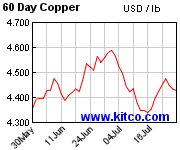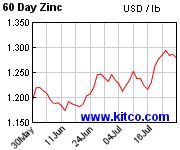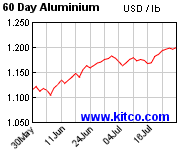Two stories this week give me some concern.
From Reuters:
Aluminum prices and volatility may surge further over coming weeks as a fund with an already large exposure slowly tightens its grip via the options market.
Data have shown one player controlling more than 90 percent of available or on warrant stocks of aluminum– about 600,000 tonnes worth about $1.6 billion– in London Metal Exchange warehouses.
Analysts and traders think that player is a U.S. hedge fund, but would not name it. The large holding has made the market nervous and pushed up volatility.
Traders think the same fund has been building on its LME position using call options giving it the right to buy three-month aluminum futures at a fixed price in February.



Commodity speculation will help the economy allocate resources more efficiently when speculators earn their profits by correctly anticipating movements in fundamentals. But if instead speculators buy high and sell low, they are creating problems for themselves and all the rest of us. The above reports suggest to me that we may have another case like the Amaranth Hedge Fund— somebody foolishly thinking they can manipulate the market, and then getting so deeply into trouble that they keep doubling up the bet in hopes of bailing themselves out.
And if you’re looking for more things to worry about, it always pays to visit Nouriel Roubini, who describes a hedge-fund leverage process that works like a Ponzi scheme:
You start with 20,000 euros invested by some investors into a hedge fund of funds; this is all equity. Then, this fund of funds borrows– at a leverage ratio of three– and invests the initial capital and the borrowed funds into an hedge fund. Then this hedge fund takes this fund of funds investment and borrow– at a leverage ratio of two– and invests the raised capital and the borrowed funds into a deeply subordinated tranches of a Collateralized Debt Obligation (that is itself a highly levered instrument with a leverage ratio of nine). So the final investment of 1 million has behind it 20,000 of equity capital and 980,000 of debt. So, if the value/price of the final investment falls by only 2% the entire capital behind it is wiped out. This is a credit house of cards where a dollar of capital is turned into 49 dollars of additional debt to finance an investment of 50. The systemic dangers/risks of this fragile credit house of cards are complicated to assess as they depend on how much of this debt/credit accumulation is concentrated or spread among many financial intermediaries. But, at face value, this kind of leverage ratios looks scary.
As I’ve warned before, an investor is foolish to judge profitability on the basis solely of recent performance– schemes like the one above may record some spectacular short run profits but will eventually wipe you out with probability one. But if you haven’t seen the balance sheet of the fund in which you’re investing (and the balance sheets of its investments in turn), there’s really no way to be sure whether this is what’s being done with your money.
Let me then repeat my recommendation that no more than 10% of the assets of any pension fund should be held in enterprises for which there is no publicly available audit. I would also favor restrictions on commodity exchanges that no more than, say, 40% of the outstanding volume on a given contract or $500 million total capitalization, whichever is larger, should be held by any one entity.
And my advice to individual investors remains: if you want to hold on to your money, make sure you understand how you earned it.
Technorati Tags: hedge funds,
commodity prices
Professor, I don’t think your advice to either pension funds or individual investors to understand their investments is likely to be heeded. I have often wondered how people make decisions under uncertainty and have come to the conclusion that there are very few people that can resist the influence of others even if the decision made doesnt seem quite correct. After all Keynes said “Worldly wisdom teaches that it is better for the reputation to fail conventionally than to succeed unconventionally”
Sorry about the double post but the first one didn’t display correctly.
Didn’t the Hunt’s try to do this with silver a couple decades ago & got stoned?
http://en.wikipedia.org/wiki/Nelson_Bunker_Hunt
http://www.buyandhold.com/bh/en/education/history/2000/hunt_bros.html
I suppose the hedgies are smarter though – they got MBAs.
Will we return to a time when the risk-free rate of return is high enough to reduce this kind of speculation?
The whole notion that markets represent the aggregated wisdom of many interested parties sort of breaks down when one account runs the show.
Gavin, I offer the suggested restrictions on pension funds and commodity exchanges not as investment advice but as proposed legislative remedies.
Does this mean we should short Aluminum futures?
Should You Short Aluminum?
That seems to be the implication of this posting by James Hamilton at Econobrowswer.
I’d want to know exactly what this nameless hedge fund’s positions are before advising a bet against them, EclectEcon. And even then, although shorting sounds like it would have a positive expected return, it also could have a very big variance (while we wait for the fund to finally crash) that would make this an unattractive investment vehicle for many people. So I guess my clearest recommendation would be to get any equity you might have in such a fund out to higher ground before the tsunami comes.
JDH:
One testable implication of this theory is that out-of-the-money puts should be priced at a higher volatility, compared to the hypothesis of no market manipulation occurring. Does the data square with this prediction?
James
An important point about Aluminium is that the supply is unusually flexible compared to other metals.
Most of the cost is manufacture, and in particular the cost of *electric power* for smelting.
So if prices are high enough, there is marginal smelting capacity can come on stream/ existing facilities can be run harder.
Also recycled aluminium is a significant component of the world market (it’s not a pure substitute, it isn’t strong enough for many applications).
Put it another way, aluminium is a relatively price elastic metal, much more so than many others. More akin to steel in that regard, than, say, copper.
The suggestion that pension fund assets in non-public-audited entities be capped is an interesting one and worthy of greater exposition.
What will it accomplish that the “Prudent Man Rule” doesn’t, and why is that better? Is it superior to the idea that pension funds
in some kind of standardized XML format so that anybody with a bit of software can construct graphs and scatter diagrams?
The problem with “market corners” in commodities is that you have to sell in order to realize your profit . . . . . . . . that is, the mechanism used to spike the price is taking delivery of the physical commodity at contract expiration – but in so doing, the speculator ends up holding an enormous physical position (by definition).
Markets being smart, when the speculator either tries to sell physicals or sell futures, the price typically undergoes a big, fast decline.
PS: The Hunts were buying physical silver and futures and were threatening to “take delivery” on more silver than the world had available . . . . . . under which circumstances the exchanges had the legal right to raise margin requirements which forced the Hunts to sell some of their holdings and the rest is history.
James
Related to what you say.
You should be aware that CALPERS published the performance of the private equity LLPs in which it was invested.
As a result, many of those PE firms refused to accept further investment from CALPERS (subscriptions to further funds)– CALPERS was actually in breach of some of its legal agreements with those funds, by publishing that data.
They very quickly took the data down off their website.
I imagine similar restrictions exist for top hedge funds.
Thus do the world’s leading pools of private capital protect their confidentiality.
While I would like to see investment returns for pension funds posted, broken down by asset class in some meaningful way, I’m not sure that giving returns for individual investments is desirable, informational, or even feasible, given intra-period trading. I’d like to hear some arguments going each way regarding that level of detail.
James
In the case of private equity, and to some extent hedge funds, unless you have performance by fund, you really don’t have any information that is meaningful. This is because the funds are so diverse in their performance and strategy.
So a city pension fund, which might have $5bn of assets, might invest 15% in alternative assets: $375m in private equity, and $375m in hedge funds.
Of that $375m slug, it might be invested in 5-10 different funds (typically Limited Partnerships).
If you don’t have the data on the performance of each of those LPs, you don’t know what is going on.
The actual investments made by each of those partnerships, you probably only need to know on an annual basis– hence the audit.
What was concerning with Amaranth was that the fund holders thought it was a ‘multi strategy’ fund, and therefore of lower risk. What they didn’t know was that of the $9bn Amaranth was investing of its clients money, $6.5bn was a bet on North American natural gas prices going up.
Hardly an undiversified risk. I think investors will get back about 30 cents on the dollar.
Of the hypothetical city pension fund, I want to see the return for the private equity asset class and for the hedge fund asset class.
What worries me about demanding to see the individual fund returns is the question of micro-management. I want to have enough information that I can hold the overall fund manager’s feet to the fire on risks and returns. But if I need to ask for too much information (however “too much” is defined) then I have to ask myself: what am I paying him for?
The futures markets, especially in metals, are paper based and in the past three years have had little correlation with the normal supply/demand fundamentals of the physical market. In other words, leveraged speculation by coordinated groups of financial entities.
The sudden collapse in oil futures from nearly $80 to $60 over the summer was related to a shift in paper holdings of an index fund that exposed several hedge funds attempting to repeat a short term corner through leveraged paper holdings.
The metals markets have been, and are, dominated by paper holdings by super groups of financial speculators and ETF’s that have driven prices up beyond reason.
My conclusion is that the futures market is seriously broken and is a vehicle for price distortion and fixing. The futures market bears little resemblance to the textbook definition of an efficient market and has cost consumers billions in unfair price gouging over this past cycle of Federal reserve induced financial speculation and larceny.
Speculators be damned. The markets are supposed to serve the consumers and suppliers by establishing cost plus reasonable economic returns. Not paper monopolies accompanied by short term price gouging followed by spectacular busts and industry oversupply.
It is time to abolish the CFTC and the concept of financial self regulation of the futures market.
James
that return for a ‘class’ of hedge funds or PE funds is essentially meaningless. The dispersion of returns between funds, and fund strategies, is too wide.
It’s the ultimate specific risk investment (rather like buying an office building in Paris, than a REIT which invests in global property).
What you are buying when you invest in these asset classes is individual manager skill (and adherence to strategy, eg long-short market neutral).
The question is not ‘did my investment in private equity work out?’but ‘did my investment in Jim’s buyout fund (PE fund) work out?’
The whole area of PE funds and Hedge funds is a nightmare of lies (to put it impolitely) and misrepresentations about returns– it is completely untransparent. The top advisory firms (Cambridge Associates, Yale Endowment etc.) spend huge resources building up a true picture of performance (read David Swensen’s 2 excellent books on asset allocation 1. for endowments and 2. for individuals for an insight into how Yale does it, and an impression of why they are the best university endowment in America).
That is why you should never believe a hedge fund index except as a general guide: it has massive survivor bias (the hedge funds are only included if they have done well, if they failed they disappear). Similarly the dispersion of returns on PE funds is so vast its almost not meaningful to talk of it as an ‘asset class’.
For a public pension fund like CALPERS, does that data need to be in the public domain? Well, if we want to assess the performance of the Trustees of CALPERs in terms of picking funds, then we have to know what they invested in. We could possibly turn that audit over to an outside body, which keeps the performance data confidential, *if* we trust that outside body.
The question is not ‘did my investment in private equity work out?’but ‘did my investment in Jim’s buyout fund (PE fund) work out?’
There is our fundamental disagreement. My question is neither of those, but rather “Is the lead manager chosen by the trustees doing a good job?”
Well, if we want to assess the performance of the Trustees of CALPERs in terms of picking funds, then we have to know what they invested in.
Not as a matter of course. That kind of detail’s for the trustees. If I had time and money for a proper analysis, I wouldn’t need to pay them.
Another problem with requiring disclosure of individual investments and their performance is that it will discourage risk taking, and there’s quite enough discouragement already. Let us say we, as trustees of the Econbrowser Pension Fund, have the opportunity to invest in “Thinkers’ Value Fund”. And we agree, after thorough analysis, that the probable return distribution is: 20% chance of 100% return & 80% chance of complete loss of investment.
This is potentially interesting. If we could come up with a thousand funds like this (with uncorrelated returns!), why would we invest in anything else?
With the degree of public disclosure you are suggesting, the trustees won’t go for it. Can’t you just see the headlines? “Econbrowser Pension suffers complete loss on Thinkers’ Value Fund! Professors’ retirement money put into ‘Extremely Risky’ investments, charges Hamilton”
Just buy IBM. Nobody ever got fired for buying IBM.
Oops, screwed up the probability distribution for VTF! Anyway, choose bimodal numbers with the average being really good.